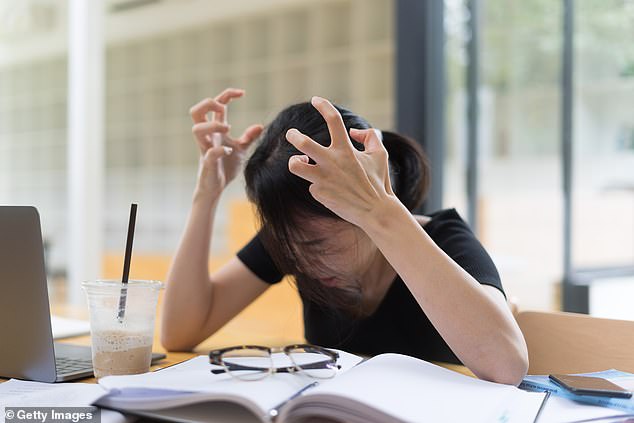Diagnoses of attention-deficit/hyperactivity disorder (ADHD) have been steadily increasing over the past decade, but some experts are warning that there’s still one demographic that’s being overlooked: women.
Much of what scientists know about ADHD comes from studies that have focused on men, but the disorder manifests very differently in women, said Dr. Janina Maschke, a cognitive psychologist and ADHD coach.
Women with ADHD are often dismissed for their symptoms, which can include shyness, sensitivity to noise, and emotional volatility. They are often told they are just “excited” or that their symptoms are caused by their period, anxiety, or depression.
Men, on the other hand, tend to deal with impulsivity, hyperactivity and inattention more frequently than women with this disorder.
This created a system in which three times more men More women than men are diagnosed with this disorder.
Women with ADHD have difficulty organizing and concentrating, but they also have different symptoms that doctors might miss, including emotional sensitivity and shyness, Dr. Maschke said.
Some estimates indicate that up to 75 percent of women with this condition are undiagnosed. according to the Canadian Centre for ADHD Awareness (CADDAC).
That’s partly because women cope more easily if they suppress their symptoms, said Dr. Sasha Hamdani, a psychiatrist in Kansas City.
“Society rewards women for masking their symptoms,” says Dr. Hamdani. posted on TikTok.
They mask these symptoms because women are socialized to be “less disruptive and more docile,” according to the Sachs Center for the treatment of ADHD and autism. In turn, they may develop coping mechanisms such as becoming detail-oriented or hyper-organized to hide their inner turmoil.
To help give people a concrete idea of what this might look like in women, Dr. Maschke He told Newsweek 15 ADHD symptoms that women often suffer from and that you may not recognize are characteristic of the condition.
These include: seeming withdrawn and shy, being emotionally volatile, frequently daydreaming, being talkative but not a good listener, seeming unmotivated, being sensitive to noise or fabrics, taking longer to process information, slamming doors, being easily distracted, making careless mistakes, and often interrupting others or saying words without thinking.
Some suggest that someone with ADHD already has a busy mind and that unexpected noises, smells or touches can cause extreme discomfort and overwhelm the individual, according to Community Health Network.
There are still some of the classic symptoms you may already associate with ADHD, such as difficulty staying focused, trouble staying organized, being forgetful and late, making “careless” mistakes, not completing tasks, or frequently changing focus.
“This difference in symptom presentation may lead to boys being diagnosed more frequently than girls because they externalize their symptoms and may disrupt others at school,” Dr. Maschke said.
This is why female ADHD sometimes occurs known as ADHD due to inattentionbecause women with this disorder may be better at appearing to pay attention (while appearing internally withdrawn) than men, who are more likely to act strangely when not focused.
Women with ADHD are more likely to have difficulty making friends and are 3.5 times more likely to develop an eating disorder, depression and anxiety than men with ADHD, according to CADDAC.
In contrast, men with ADHD are more likely to develop substance abuse problems.
Although the disorder may go unnoticed in some people, overall ADHD diagnoses in the United States remain high and are increasing.
CDC data shows that The number of women ages 15 to 44 who requested a prescription for ADHD medication increased by 344 percent between 2003 and 2015.
Between 2.5 and 4.4 percent of American adults, approximately 11 million people, have ADHD.
It is most often diagnosed in children: About 11 percent of Americans between the ages of three and 17 have the condition – about 7 million people. According to the Centers for Disease Control and Prevention.
That represents about a million more children with the condition than in 2016, a rising rate that prompted the CDC to declare ADHD an “expanding public health problem.”
The average age of diagnosis is seven years old and 15 percent of boys under 18 are diagnosed with the disorder, compared to eight percent of girls under 18.
Diagnoses tend to be more common among children because initially, ADHD was studied almost exclusively in children and there are no formal diagnostic criteria for ADHD in adults. Dr. Frances Levinprofessor of psychiatry at Columbia University.
Some experts therefore theorize that doctors are overdiagnosing the disease, especially in children.
But, Dr. Levin said, both stories are likely true: Some people are misdiagnosed, while others are completely ignored.
“It’s difficult to get a clear picture of how many people in this country fit a clinical definition of ADHD when there are no U.S. guidelines for diagnosing and assessing ADHD in adults,” said Dr. Levin.
If you suspect you may have this condition, it’s best not to jump to conclusions before talking to a doctor, Dr. Maschke said.
‘As a first step, it may be a good idea to start by consulting with a pediatrician or mental health specialist who can perform a thorough evaluation.’
ADHD is usually treated with therapy and, if the patient is older than six, with medication. Therapy aims to help the person pay attention, form relationships, and self-regulate when feeling overwhelmed.

